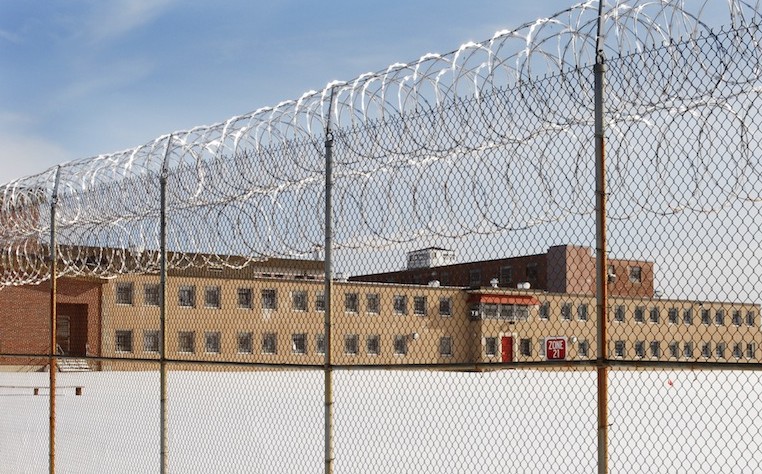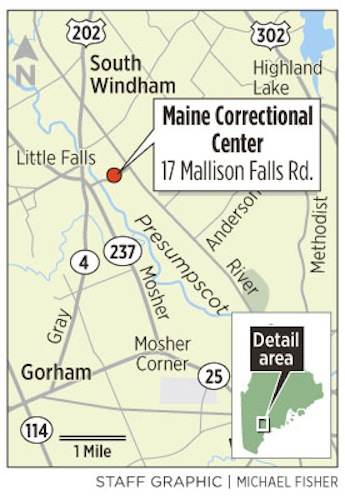AUGUSTA — Most of the Maine Correctional Center in Windham will likely be rebuilt if lawmakers approve the LePage administration’s proposed budget for the next two years – which asks for $100 million in borrowing for the project.
The proposal comes as legislators face three budget shortfalls, and more than $100 million in voter-approved bonds dating back to 2009 haven’t been issued. Gov. Paul LePage has cited the need for Maine’s fiscal health to improve before he will authorize most of the borrowing.
State officials say the project is being proposed because of dated facilities at the prison, which is composed of buildings that were built piecemeal into a campus over decades.
But Jim Mackie, spokesman for AFSCME Council 93, the union that represents Maine corrections employees, said he hasn’t heard that.
He said he sees it as Corrections Commissioner Joseph Ponte’s main objective: to increase efficiency at the expense of employees.
Under preliminary plans, eight of the prison’s 11 buildings – all built two decades ago or longer – would be demolished, said Jody Breton, spokeswoman for the Department of Corrections.
“From the road, everything you see will be gone,” she said.
Breton said the state is considering “tomorrow’s capacity” for the new, larger center – perhaps 1,000 inmates, but that won’t be known until design plans are finalized.
“It really is looking for an investment for years to come,” she said.
Breton said the facility now has 622 inmates, 530 of whom are men. Most inmates at the minimum- and medium-security prison have been sentenced to five years or less, she said.
Plans call for three newer buildings – two housing units and a women’s facility – to remain.
Breton said the state would move women from the Southern Maine Re-entry Center in Alfred, which is rented from York County, to the prison in Windham.
“The conditions of the facilities have deteriorated so bad that it’s not cost-effective to maintain them,” Breton said.
Scott Burnheimer, superintendent of the correctional center, called it “a museum of the history of corrections in Maine.”
He said the building where his office is was built in 1930, and other buildings are from the 1950s through the ’90s.
“Every decade has a building,” Burnheimer said. “When you add on new buildings, your hub is still a complex that is very outdated.”
The center has added security cameras, Burnheimer said, but there was no mapped-out rhyme or reason to the scheme.
“We’re forever adding cameras here, there and everywhere,” he said. “With a new facility, you would have that mapped out – a blueprint of high-traffic areas that you would have camera backup.”
For instance, he said, visitors to the women’s facility must be driven a quarter-mile to get there. Burnheimer said buildings with too-small rooms have bad sightlines for supervising inmates.
“A new facility would potentially allow you to watch more people with the same amount of (employees) or possibly less,” Burnheimer said, though he said that he doesn’t think construction of the new facility would cause job losses.
But Mackie, the union spokesman, said Ponte’s years in the private prison industry in other states shows what he wants.
“He came from the private prison, and that’s what those big-deal warehouse prisons are about,” he said. “His goal has always been to shut everything down and consolidate so he can run it with less people.”
Breton said she estimates five or six buildings would replace the razed buildings, but the project is still in its design phase and wouldn’t be built before 2016.
It would be built on state-owned land along Mallison Falls Road, between Route 202 and River Road.
Rep. Mark Dion, D-Portland, the House chair of Legislature’s Criminal Justice and Public Safety Committee, said the proposal surprised him, though he said the facility in Windham is old and renovations could be due.
In a recent, informal meeting with Ponte, Dion said, Ponte told legislators that state officials were considering a bond for construction but it was a tentative plan.
“To me, saying you’re going to build a $100 million facility and actually doing it is a multistep process,” Dion said.
Mackie said Ponte discussed the plan for a 1,400-bed Windham facility with corrections employees in a question-and-answer session several months ago.
“We know he’s wanted to build a 1,400-bed prison; what we didn’t know is where the hell he was going to find the money to pay for it,” he said. “I don’t really think the citizens of Maine are going to be willing to dole out I-don’t-know-how-many millions of dollars on a new prison.”
Dion said the facility is old and could use renovations, but it will take committee work and “a lot of meetings” to pass the plan to rebuild most of it.
“We have to explain that to the people, and prisons and jails are never popular,” Dion said. “When you choose that, you’re choosing it at the expense of something else.”
LePage’s proposal asks for the Maine Governmental Facilities Authority to be given permission to issue as much as $100 million in bonds for the costs.
The authority can issue bonding after a majority vote of the authority’s board and a two-thirds vote in each house of the Legislature. Voter approval is not needed.
In a prepared statement Monday, House Speaker Mark Eves, D-North Berwick, said legislative leaders were “reviewing the details of (LePage’s) correctional proposal now” and “Democrats are hopeful that we can find common ground with the governor and Republicans on making needed economic investments in our roads, bridges, and our state buildings.”
State House Bureau Writer Michael Shepherd can be reached at 370-7652 or at:
mshepherd@mainetoday.com
Send questions/comments to the editors.



